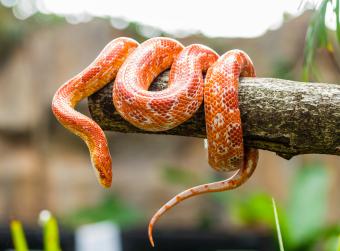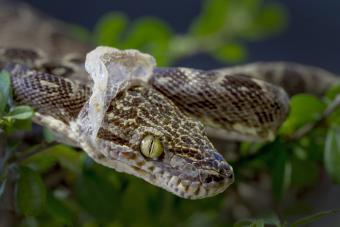
Boa constrictors are heavy-bodied snakes found in tropical South America. It was long thought to be the world's largest snake, but has since been surpassed by other species, such as the reticulated python and the green anaconda. Despite their size, they are relatively easy to keep as pets and are amenable to being handled by people.
In the Wild
Boa constrictors are found in a variety of habitats, including rainforests, deserts, and savannas. They live on the ground or in trees and bushes in their native habitats and have been known to climb as high as 20 feet (6 meters) above the ground.
Primitive Snakes
The boa constrictor gets its name from the manner in which it captures and kills its prey. Once the snake has bitten its prey to hold on to it, it constricts its body around the animal to use its powerful body to kill the animal by cutting off its blood supply. The boa constrictor is one of the few animals that has the same "common name" as their scientific name, which is also a boa constrictor.
Other names for the boa constrictor are the red-tailed boa, the common boa, and "jiboia" in Latin America. Boa constrictors are primitive snakes, which means they have two lungs instead of one and their skeletons still have a vestigial set of back legs and pelvic bones.
They transfer odor into their highly developed vomeronasal organ with their tongues. With their "pit organs" positioned near their eyes, they can see in the ultraviolet spectrum and detect animal body heat.
Native Habitat
Boa constrictors can be found in Mexico, Central America, South America, and the Caribbean. They can also be found in Florida and the Virgin Islands, although they are not native species and are considered invasive. Boa constrictors tend to live in rainforests and prefer to live by the water, although they can be found in other types of habitats. They are considered "habitat generalists" and can adapt to a variety of environments, even urban ones, which is part of the reason they are relatively easy to care for in captivity.
While adult boa constrictors tend to live on or near the ground, their young are arboreal. Boa constrictors are considered a threatened species in their native habitat and are listed in the Convention on the International Trade of Endangered Species (CITES).
General Characteristics
In order to keep your boa constrictor healthy and happy, it's important to have the right kind of habitat for them and ensure their temperature needs are met.
Appearance

Boa constrictors are among the world's largest snakes, measuring 8 to 13 feet in length, with lengths above 11 feet considered rare. They range in weight from 60 to 100 pounds.
Boa constrictors come in a variety of colors, from brown to red to yellowish-green. Diamonds, circles, and lines form different patterns on their bodies. The color of a boa constrictor can change as it sheds and ages. Snakes that are older have deeper hues than snakes that are younger. Albino boa constrictors, as well as unusual color patterns developed via breeding known as "morphs," are prominent in the pet breeding trade. This snake is recognized for their unique color pattern, which is similar to that of the coral snake. This species' lack of ventral scales got it the nickname "boa," which means "no belly" in Portuguese.
Diet

Boa constrictors in the wild typically eat amphibians, birds, bats, rodents, and other small animals. Larger boa constrictors in the wild have been known to prey on monkeys, pigs, ocelots, and even small deer. A boa constrictor will digest their prey over the course of about four to six days.
Younger boas (less than 6 months old) should be fed every 5 to 7 days until they reach about half their adult size. Once they reach this size, feed them every 7 to 10 days until they are fully grown. Feeding too much can cause health problems and make it difficult for them to shed properly as adults.
Habitat

The ideal enclosure for an adult should be approximately 5 feet in height, 4 feet long and at least 3 feet deep. Boa constrictors are excellent escape artists, so the enclosure should be well-secured with no small openings. The enclosure should be durable and easy to clean.
Provide the snake with a "hide" where they can feel safe. Hides can be purchased at pet stores that are sculpted to look like caves or rocks, or you can use a simple box or plastic container with a hole cut in the side. Adding branches in their habitats, such as spider wood or driftwood pieces, can make the habitat feel and look more natural.
Clean the cage at least weekly to remove any urine or feces and prevent the growth of bacteria.
Tank Substrates
A variety of substrates will work well, but avoid using wood shavings such as pine or cedar, since they can become lodged in the digestive tract and cause health issues. Instead, choose from fir bark, shredded aspen, newspaper, corrugated cardboard, or craft paper.
Temperature Requirements
Snakes need external sources of heat since they cannot regulate their body temperatures. In the wild, they use the sun for this purpose. When keeping a boa constrictor as a pet, you will need to maintain a proper temperature in your snake's habitat. The snake needs to be able to move from warmer to cooler areas of the enclosure.
During the day the temperature in the main part of the habitat should be between 80 to 85 degrees Fahrenheit, with a basking area of about 95 degrees. Temperatures at night should be between 75 to 80 degrees Fahrenheit. There are several ways you can heat and maintain the temperature of the habitat. Heat the enclosure with ceramic emitters, heat lamps, and heating pads.
Heat lamps and ceramic elements can be mounted to the top of the enclosure to direct heat downward. Heat tape or adhesive pads can be placed on the underside of the glass enclosure. They do not require UV (ultraviolet) light to maintain their health, but you can use a light if you prefer. If you choose to use light, use full-spectrum lighting or a low-watt incandescent bulb during the day. Place the lighting in a way that the snake does not come into direct contact with the bulb. Snakes can be seriously burned if lights are placed incorrectly.
Humidity
In addition to their temperature requirements, you need to maintain the right level of humidity in their aquarium. An ideal range is 60 to 75 percent, which can be achieved with misters and a bowl of water in the tank. Your bowl should be one that is too heavy for the snake to knock over and ideally large enough for the snake to move its body through to cool off. Water should be cleaned and replaced often though, as boas have a tendency to urinate in their water bowls.
What to Feed a Boa Constrictor

Boa constrictors are carnivores and eat live prey. Typical food choices for a pet boa constrictor are mice, rats, chicks, and even small rabbits. Pet boa constrictors in captivity can eat pre-killed prey such as rats and mice. A good rule of thumb to remember when feeding is that the prey should be no wider than the widest part of the snake's body. Always provide your boa with a clean bowl of water to go along with their meal.
Boa constrictors can be fed once a week to a couple of times per month, depending on the age of the snake. Baby boa constrictors grow faster than adults, so they require more frequent feedings. Snakes up to a year old should eat every seven to 10 days, and then every two weeks until they reach their second year. After this, females can eat every three weeks, and males typically eat every two weeks. Once they reach age three, you can move to a final feeding schedule of every three or four weeks for a female and every two to three weeks for a male.
It's best to use reptile tongs to feed your boa constrictor, as you do not want the snake to confuse your hands with the prey. This can lead to bites, as the snake's vision is weak and it may confuse the heat coming from your body with the prey and bite you by accident. It's also very important to wash your hands thoroughly after handling their food, because the scent can confuse them, as well.
Handling
While boa constrictors are not dangerous to adult humans, they can bite if they feel stressed or startled or during shedding season when they are irritable. Though they are non-venomous snakes, the bite can still be quite painful as can constricting if they get ahold of you.
Care should be taken to not allow children to handle boa constrictors, as there is a risk of the snake getting around a child's neck and constricting if the snake feels stressed and uncomfortable. It's also a good reason to never let a boa constrictor wrap around an adult body, as well. You should also avoid handling a boa constrictor after it has had a meal, because there's a chance it will regurgitate its meal.
Boa Constrictor Mating and Birth Facts
Unlike pythons, the boa constrictor is viviparous, which means they give birth to live snakes rather than laying eggs. Gestation for a boa constrictor is between five and eight months. When a boa constrictor gives birth, they can have up to 60 live baby snakes that can live independently of their mother right at birth.
There have been recorded instances in the wild of female boa constrictors giving birth without mating to a male, which is known as parthenogenesis. Females and males may mate with more than one snake during mating season, which is usually from April through August.
Legality
Boa constrictors are classified as exotic pets, and there are laws that vary from state to state regarding the ownership of exotic animals. For example, Florida requires boa constrictor owners to have a permit, while Pennsylvania has no specific laws regarding reptiles. Each state has different laws, so before getting a boa constrictor to keep as a pet, you should contact your local game commission or city or county animal control department to find out the legal aspects of ownership. Certain large constrictor snakes are prohibited by the U.S. Fish and Wildlife Service Lacey Act in Florida, but the boa constrictor was not included in the 2015 law.
Veterinary Care
A new pet boa constrictor should go to the veterinarian for an initial examination, then follow up with routine visits to maintain their health. Boa constrictors can become infested with parasites that could eventually be fatal. Some infestations can also be transmitted to humans, so it is important to always cleanse your hands after handling your pet or its habitat. Boa constrictors are also susceptible to respiratory conditions and skin diseases. Boa constrictors can live 20 to 30 years in the wild, so with proper care and maintenance, your boa can lead a long, healthy life.
Is a Boa Constrictor Right for You?
Though Boa constrictors are docile by nature, their sheer size and strength can make them dangerous for inexperienced owners. If you're interested in owning a boa, research first on general care, proper habitat set-up, diet, and handling. Be sure that you can provide your boa with what they need and if you ever do get one as a pet, be very careful when handling them. If you plan to display your snake in a terrarium, make sure it's escape-proof. Remember, always to exercise caution when working with pets of this length and strength.







